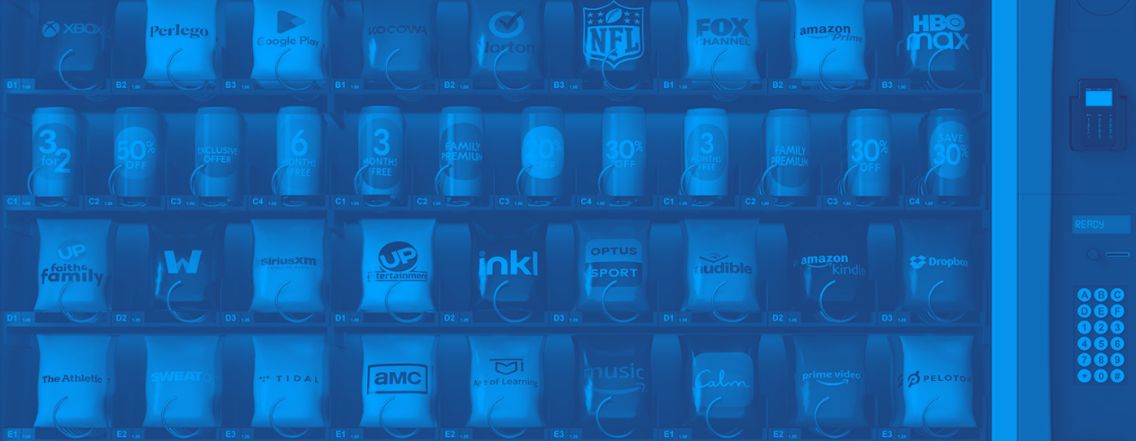Today, the subscription market is experiencing rapid growth. In response to this, telecom operators are turning to the creation of Super Bundling offers to retain their customers and differentiate themselves from each other. This presents a significant opportunity for content providers and payment services.
The subscription market is booming. According to a Juniper Research study, the subscription market is projected to grow from $100 billion in 2018 to an expected $600 billion by 2026.
What’s even more remarkable is that the number of subscriptions per consumer is set to double, going from an average of 2.2 to 5.3 subscriptions per person over the same period.
This has captured the attention of all players looking to establish and expand their presence in the subscription market.
This explosive growth is driven by consumers’ increasing desire for subscriptions to meet almost all their needs, including music, video, health, gaming, takeout, and even retail, among others. Paradoxically, consumers find themselves in an ambiguous situation.
On one hand, they want to subscribe to more services to satisfy their craving for choice and flexibility. On the other, they wish to spend less time managing these subscriptions and dream of centralizing their subscriptions with a single entry point, up to a single payment method and a single bill.
Bango, a British startup specializing in the construction of white-label subscription hubs primarily for telecom operators, conducted a study by interviewing 2,500 American consumers.
Among them, 62% are willing to take on more service subscriptions if it were easier to manage them.
Even worse, 71% of those interviewed would spend more time using their subscription services if they were centralized on one app or platform.
Some other significant figures from this study include:
- 35% don’t know how much they spend on subscriptions per month.
- 72% feel there are too many different subscriptions.
- 77% of consumers interviewed want to pay for all their subscriptions through a single bill.
And this is where the concept of “Super Bundling” is born.
Super Bundling: What is it, exactly?
In concrete terms, Super Bundling, or “super-bouquet” in good French, is quite simple.
It’s a platform or app that offers a content hub of subscription services, encompassing all types of offers, centralized and manageable in one place, with a single billing system.
Offer bundling has existed for a long time among telecom operators, first by mixing their own offerings (mobile, fiber, etc.), and then by integrating related partner offerings in sports or streaming, for example.
With the emergence and growth of subscriptions in today’s lifestyle, companies, especially telecommunications operators but not exclusively, are facing a new demand where they must push the boundaries of their well-known bundled offerings. They need to provide consumers with a bundle of partner offers called “Super Bundling,” perfectly aligned with what consumers desire: a platform centralizing dozens of subscription services that are actionable and consumable on the fly, with a single payment system.
For consumers, it’s a dream come true.
Telecom companies are at the forefront of providing this kind of super service, but they’re not alone. In fact, all service providers struggling to differentiate themselves in the market could do so by implementing Super Bundling. This includes energy companies and even banks.
What are the benefits of such an offering?
Super Bundling offers a range of advantages for each stakeholder:
For merchants (content providers):
- They gain instant access to millions of potential customers with a single, easy integration.
- By joining the Super Bundling “movement,” they can benefit from the reach of telecom operators and their marketing power, enhancing their visibility and reputation.
It’s worth noting that in the US in 2023, 20% of all online video subscriptions will be sold through bundled offerings by telecom operators. In some regions, like Latin America and the Caribbean, nearly half of streaming video-on-demand services will be sold through telecom operators by 2026.
For consumers:
- Super Bundling offers them access to a wide range of diverse content, including games, music, dating, productivity, food, and more, all on a single platform with a single bill.
- It gives them better control over their digital services, allowing them to subscribe, pause, resume, and cancel subscriptions in one place.
For telecom operators:
- Super Bundling can increase their revenue by attracting new customers and, more importantly, by retaining existing ones.
- It allows telcos to position themselves as content providers alongside their core business, meeting the expectations of their customer base.
- Operators can become gateways to a rich content ecosystem for consumers, thus strengthening their position in the market.
Super Bundling offers significant benefits to consumers in terms of choice and control, to merchants in terms of access to a broad audience and visibility, and to telecom operators in terms of diversifying their offerings and increasing revenue.
This model appears to be rapidly growing, especially in the field of online video subscriptions, but it also presents opportunities for other types of subscription-based services.
Images Bango.com




